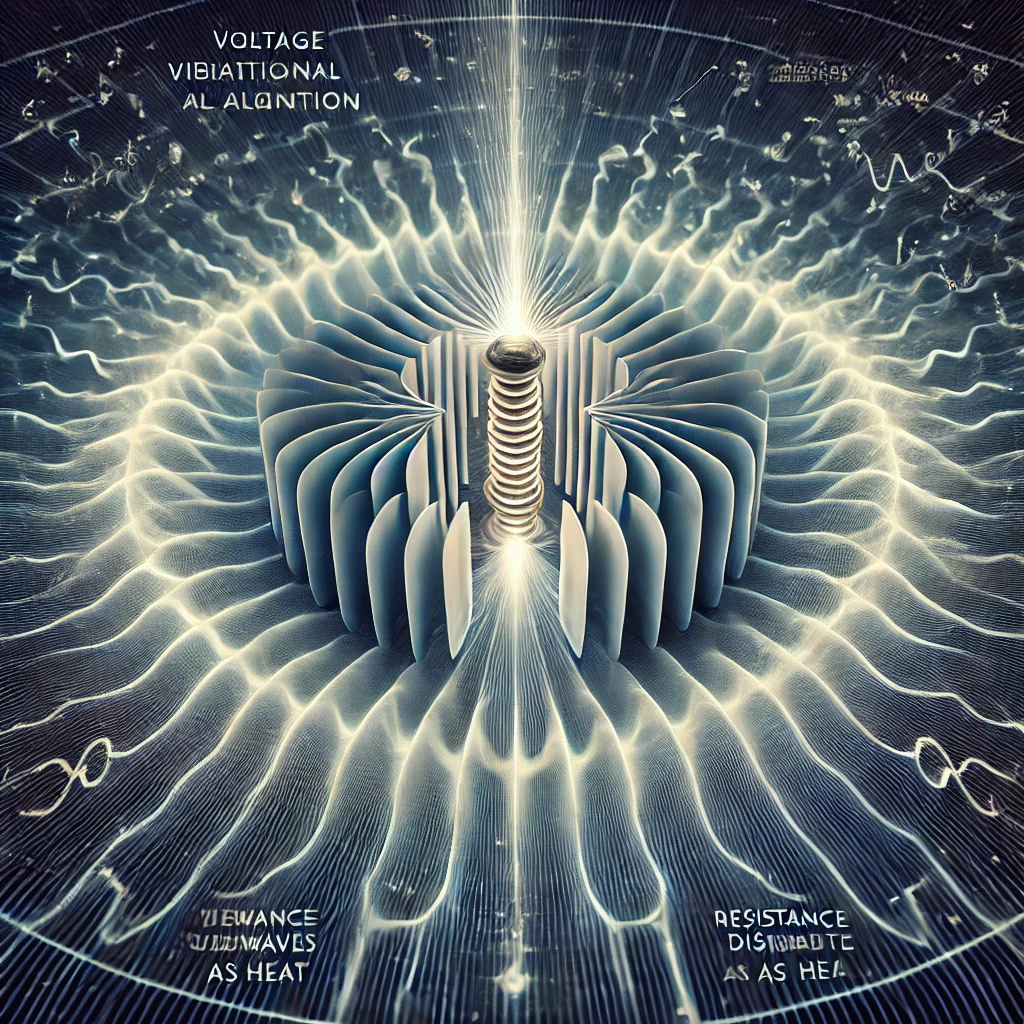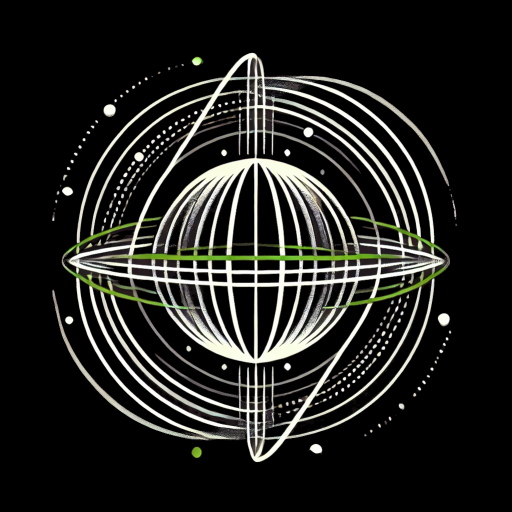Exploring Electricity Through VFD

In Vibrational Field Dynamics (VFD), electricity is not just the flow of electrons or a result of charges moving through a conductor. Instead, it is a dynamic interaction of vibrational fields, where electric currents, voltages, and resistances emerge as patterns within a field of resonant frequencies. Here, we’ll explore the core components of electricity—such as voltage, current, and resistance—through the lens of VFD and examine how this perspective reshapes our understanding of traditional electric formulas, like Maxwell’s equations.
Voltage: The Potential Difference as Vibrational Alignment Energy
In classical physics, voltage (or electric potential difference) is defined as the energy needed to move a charge between two points. Within VFD, voltage is interpreted as a difference in vibrational alignment within the field, where varying vibrational potentials create a “push” or “pull” effect.
Voltage in VFD
In VFD, each point in a conductor has a unique vibrational frequency that resonates with the surrounding field. When there is a difference in frequency alignment between two points, it creates a tension—a potential energy that drives the vibrational flow. This difference in alignment is what we perceive as voltage.
Analogy: Imagine two points on a stretched rubber band, one more taut than the other. This difference creates tension between the points, similar to how voltage represents a difference in vibrational alignment, causing particles to “move” or adjust.
Mathematical Interpretation
In VFD, voltage ![]() is the potential energy per charge
is the potential energy per charge ![]() arising from alignment differences within the vibrational field. This aligns with the formula
arising from alignment differences within the vibrational field. This aligns with the formula ![]() , where
, where ![]() (work) in VFD terms is the energy required to realign vibrational frequencies from one state to another.
(work) in VFD terms is the energy required to realign vibrational frequencies from one state to another.
Current: The Flow of Vibrational Energy
Current is traditionally understood as the flow of electric charges. Within VFD, current represents the flow of vibrational energy through the alignment of particles, where particles adjust their vibrational states to maintain resonance along a conductor.
Current in VFD
Current flows when there is a continuous alignment of particles’ frequencies across a conductor. This flow is driven by the difference in vibrational alignment (voltage) between two points. As particles align with each other along the conductor, they establish a resonant path that transfers energy through vibrational oscillations.
Analogy: Think of current like a series of dancers moving in sync with a beat. As each dancer (particle) receives the signal (vibrational alignment) from the previous one, they continue the movement, creating a flow of energy down the line.
Mathematical Interpretation
Current ![]() in VFD represents the rate of vibrational alignment, which correlates with the formula
in VFD represents the rate of vibrational alignment, which correlates with the formula ![]() , where
, where ![]() (charge) is the quantity of aligned particles over time (
(charge) is the quantity of aligned particles over time (![]() ). In VFD, the alignment of particles transfers vibrational energy, manifesting as current flow.
). In VFD, the alignment of particles transfers vibrational energy, manifesting as current flow.
Resistance: Opposition to Vibrational Alignment
In classical physics, resistance is the opposition that a conductor presents to the flow of current. In VFD, resistance represents the natural opposition within the vibrational field, where not all particles or regions of the field are equally able to align.
Resistance in VFD
Resistance occurs when particles or regions within the conductor cannot fully align their frequencies with the driving vibrational field. This misalignment reduces the efficiency of energy transfer and creates vibrational friction, releasing energy in the form of heat.
Analogy: Imagine trying to move a heavy chain across a rough surface. Each link wants to move with the chain but is held back by friction. In VFD, resistance is this “vibrational friction,” where particles cannot achieve perfect alignment, thus limiting the flow of vibrational energy.
Mathematical Interpretation
Ohm’s Law ![]() describes how voltage (vibrational potential) is related to current (flow of alignment) and resistance (opposition). In VFD, resistance
describes how voltage (vibrational potential) is related to current (flow of alignment) and resistance (opposition). In VFD, resistance ![]() is the measure of how much vibrational misalignment opposes the current. This misalignment translates into energy loss, as particles that cannot fully align cause energy dissipation.
is the measure of how much vibrational misalignment opposes the current. This misalignment translates into energy loss, as particles that cannot fully align cause energy dissipation.
Electromagnetic Waves: Coupled Vibrational Resonance
In VFD, electromagnetic waves are self-sustaining oscillations of electric and magnetic fields that propagate as coupled vibrational resonances. These waves emerge from interactions in the field where electric and magnetic components oscillate in harmony, maintaining alignment and transferring energy through space.
Maxwell’s Equations in VFD
Maxwell’s equations describe how electric and magnetic fields interact, propagate, and influence each other. In VFD, these equations are interpreted as field relationships where vibrational alignment generates both electric and magnetic resonances that sustain each other as an electromagnetic wave.
- Gauss’s Law for Electricity: This law describes how electric fields emanate from charges. In VFD, charges generate a localized vibrational pattern, creating a surrounding field that aligns other particles to its frequency.
- Gauss’s Law for Magnetism: Traditionally, it states that there are no magnetic “monopoles.” In VFD, magnetic fields are seen as rotational alignments within the vibrational field. These fields must remain in a balanced, dual-pole structure, as the vibrational patterns support only such aligned formations.
- Faraday’s Law of Induction: This law describes how a changing magnetic field induces an electric field. In VFD, a change in magnetic alignment creates a disturbance that realigns neighboring vibrational states, inducing an electric field.
- Ampère’s Law with Maxwell’s Addition: This law connects magnetic fields to electric currents and changing electric fields. In VFD, a current (vibrational flow) generates a surrounding magnetic alignment, which then influences adjacent vibrational states to sustain the wave.
Electromagnetic Wave Propagation in VFD
In VFD, an electromagnetic wave is a self-propagating disturbance of vibrational alignment. As electric and magnetic resonances reinforce each other, they create a wave that maintains alignment even as it moves through space.
Capacitance and Inductance in VFD
Capacitance represents a system’s ability to store vibrational energy in an aligned state, while inductance is the ability to store energy in a circulating vibrational pattern.
- Capacitance: In VFD, a capacitor stores energy by maintaining alignment differences between two plates. The plates hold charges in opposing alignment, which creates a tension (voltage) that can be released as current.
- Inductance: In VFD, an inductor stores energy by creating a circulating vibrational pattern around a conductor. This pattern opposes changes in current flow, maintaining alignment in the vibrational field.
Summary: Electricity in Vibrational Field Dynamics
In Vibrational Field Dynamics, electricity is reinterpreted through vibrational resonance and alignment:
- Voltage: The difference in vibrational alignment, creating potential energy.
- Current: The flow of vibrational alignment along a conductor.
- Resistance: The opposition to alignment within the vibrational field.
- Electromagnetic Waves: Coupled oscillations of electric and magnetic fields as self-sustaining vibrational patterns.
- Maxwell’s Equations: Interactions within the vibrational field that define electric and magnetic resonances.
This framework suggests that electrical phenomena are expressions of vibrational alignment, opening new perspectives on how electricity functions within a unified vibrational reality.



Leave a Reply